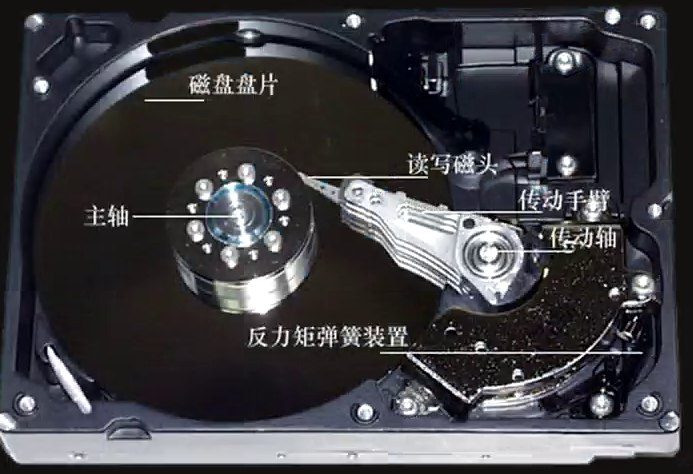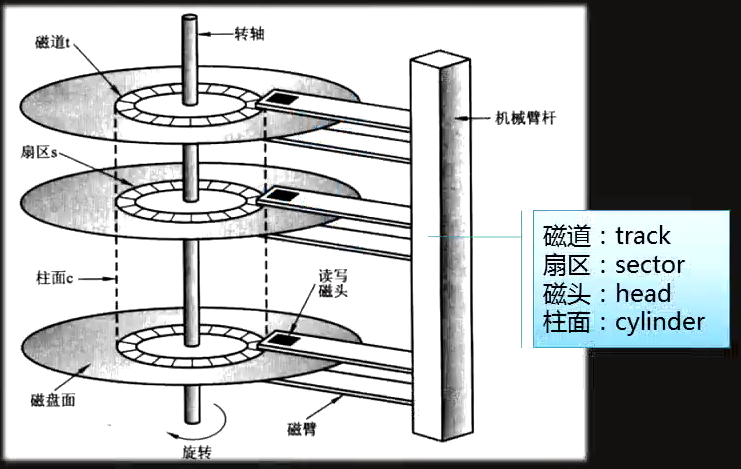一、Linux系统磁盘概念
磁盘的结构体系
01. 磁盘的物理结构 (外部结构 内部结构) 工作原理(先切换磁头 让磁头镜像运动)
02. 磁盘阵列说明 (raid0 raid1 raid5 raid10 raid01)
磁盘阵列如何配置
配置LVM L 逻辑 v 卷组 M 管理 逻辑卷管理 --> 实现可以随意调整磁盘分区大小
03. 磁盘分区概念
给容量较小的磁盘进行分区: 小于2T fdisk
给容量较大的磁盘进行分区: 大于2T parted
04. 磁盘格式化操作(创建文件系统)
05. 磁盘维护管理知识(如何使用磁盘 挂载使用)
磁盘层次结构详细说明--物理结构
1、磁盘的外部结构: 看的见摸得到的结构

组成部分
a 磁盘主轴 决定磁盘转速(rpm-round per minute)
家用磁盘转速 7200 rpm 5400 rpm
企业磁盘转速 15k rpm 10k rpm
b 磁盘盘片 用于存储数据
c 磁盘磁头 用于读取数据
d 磁盘接口 用于连接主板 用于连接阵列卡
2、磁盘的内部结构: 看不见的结构信息

组成部分:
a 磁盘(Disk) 磁盘或者分区的大小 = 柱面大小 * 柱面数
b 磁头(Head)(一个柱面有255个)
作用说明:用来写入和读取数据的
特点说明:盘面数量等于磁头数量
工作原理:采用径向运动读写数据
c 磁道(Track)每个磁道划分为63个扇区
作用说明:用来存储用户数据
特点说明:由多个同心圆组成
存储计数:最外面同心圆为0磁道
工作原理:磁盘默认按照磁道寻找数据
重点原理:磁头径向运动为机械运动(寻道) 性能小于固态硬盘(芯片)
原理特点:磁头机械运动较慢
d 扇区(Sector)
作用说明:用来存储用户数据
特点说明:磁盘存储最小单位
存储计数:默认磁盘扇区从1扇区开始,扇区大小为512字节
系统存储最小单位是block
e 柱面(Cylinder) 一个柱面的大小=255*63*512字节=8M
作用说明:用来存储用户数据
特点说明:不同盘面上相同的磁道组成(圆柱体)
工作原理:磁盘默认按照柱面进行读写
重点原理:磁头之间的切换为电子切换
原理特点:磁头电子切换较快
f 单元块(Units)
作用说明:用来存储用户数据
特点说明:表示单个柱面大小
磁盘层次结构详细说明--磁盘阵列raid
阵列有什么用?
1) 提高磁盘存储效率
2) 提高磁盘存储安全
3) 提高磁盘存储容量
阵列的配置方法:
raid 0 存储数据效率高 存储安全性低
raid 1 存储数据效率低 存储安全性高
raid 5 存储数据效率较高 存储安全性较高
说明: 至少有3块磁盘 raid5阵列中只能最多坏一块磁盘 损耗一块磁盘的容量
300G 300G 300G --> raid5 --> 600G
LVM 实现分区可以弹性缩融 和 扩容
磁盘层次结构详细说明--磁盘分区方法
预备知识:
a 系统启动引导记录--
MBR引导记录 用于引导磁盘空间小于2T
GPT引导记录 用于引导磁盘空间大于2T
b 分区方式
情况一:
可以划分4个主分区 /dev/sda /dev/sda1 .. sda4 mount /dev/sda1 /mnt
情况二:
可以划分3个主分区 /dev/sda /dev/sda1 .. sda3
可以划分1个扩展分区 扩展分区无法直接使用
需要在扩展分区基础上划分逻辑分区: /dev/sda5 /dev/sda6 ...
二、磁盘层次结构--磁盘分区方法

情况一: 磁盘分区实践--磁盘小于2T
第一个里程: 准备磁盘环境
准备了一块新的10G硬盘
第二个里程: 在系统中检查是否识别到了新的硬盘
检查是否有新的磁盘存储文件
[root@oldboyedu ~]# ll /dev/sdb
brw-rw----. 1 root disk 8, 16 Apr 28 08:54 /dev/sdb
第三个里程: 对磁盘进行分区处理(fdisk-- 进行分区处理 查看分区信息)
fdisk -l --- 查看分区信息
[root@oldboyedu ~]# fdisk /dev/sdb
Welcome to fdisk (util-linux 2.23.2).
Changes will remain in memory only, until you decide to write them.
Be careful before using the write command.
Device does not contain a recognized partition table
Building a new DOS disklabel with disk identifier 0x6c918c6d.
Command (m for help): 可以对磁盘进行分区了
Command action
d delete a partition *****
删除分区
g create a new empty GPT partition table
创建一个新的空的GPT分区表(可以对大于2T磁盘进行分区)
l list known partition types
列出可以分区的类型???
m print this menu
输出帮助菜单
n add a new partition *****
新建增加一个分区
p print the partition table *****
输出分区的结果信息
q quit without saving changes
不保存退出
t change a partition's system id
改变分区的系统id==改变分区类型(LVM 增加swap分区大小)
u change display/entry units
改变分区的方式 是否按照扇区进行划分
w write table to disk and exit *****
将分区的信息写入分区表并退出==保存分区信息并退出
开始分区:
a 规划分4个主分区 每个分区1G
分区操作过程
Command (m for help): n
Partition type:
p primary (0 primary, 0 extended, 4 free)
e extended
Select (default p): p
Partition number (1-4, default 1): 1
First sector (2048-20971519, default 2048):
Using default value 2048
Last sector, +sectors or +size{K,M,G} (2048-20971519, default 20971519): +1G
Partition 1 of type Linux and of size 1 GiB is set
分区操作检查:
Command (m for help): p
Disk /dev/sdb: 10.7 GB, 10737418240 bytes, 20971520 sectors
Units = sectors of 1 * 512 = 512 bytes
Sector size (logical/physical): 512 bytes / 512 bytes
I/O size (minimum/optimal): 512 bytes / 512 bytes
Disk label type: dos
Disk identifier: 0x3069f1dd
Device Boot Start End Blocks Id System
/dev/sdb1 2048 2099199 1048576 83 Linux
/dev/sdb2 2099200 4196351 1048576 83 Linux
/dev/sdb3 4196352 6293503 1048576 83 Linux
/dev/sdb4 6293504 8390655 1048576 83 Linux
Command (m for help): n
If you want to create more than four partitions, you must replace a
primary partition with an extended partition first.
b 规划分3个主分区 1个扩展分区 每个主分区1G 剩余都给扩展分区
删除分区
Command (m for help): d
Partition number (1-4, default 4): 1
Partition 1 is deleted
创建逻辑分区
Command (m for help): p
Disk /dev/sdb: 10.7 GB, 10737418240 bytes, 20971520 sectors
Units = sectors of 1 * 512 = 512 bytes
Sector size (logical/physical): 512 bytes / 512 bytes
I/O size (minimum/optimal): 512 bytes / 512 bytes
Disk label type: dos
Disk identifier: 0x3069f1dd
Device Boot Start End Blocks Id System
/dev/sdb1 2048 2099199 1048576 83 Linux
/dev/sdb2 2099200 4196351 1048576 83 Linux
/dev/sdb3 4196352 6293503 1048576 83 Linux
/dev/sdb4 6293504 20971519 7339008 5 Extended 有了扩展分区才能逻辑分区
Command (m for help): n
All primary partitions are in use
Adding logical partition 5
First sector (6295552-20971519, default 6295552):
Using default value 6295552
Last sector, +sectors or +size{K,M,G} (6295552-20971519, default 20971519): +1G
Partition 5 of type Linux and of size 1 GiB is set
Command (m for help): p
Disk /dev/sdb: 10.7 GB, 10737418240 bytes, 20971520 sectors
Units = sectors of 1 * 512 = 512 bytes
Sector size (logical/physical): 512 bytes / 512 bytes
I/O size (minimum/optimal): 512 bytes / 512 bytes
Disk label type: dos
Disk identifier: 0x3069f1dd
Device Boot Start End Blocks Id System
/dev/sdb1 2048 2099199 1048576 83 Linux
/dev/sdb2 2099200 4196351 1048576 83 Linux
/dev/sdb3 4196352 6293503 1048576 83 Linux
/dev/sdb4 6293504 20971519 7339008 5 Extended
/dev/sdb5 6295552 8392703 1048576 83 Linux
第四个里程: 保存退出,让系统可以加载识别分区信息
让系统可以加载识别分区文件
partprobe /dev/sdb

情况二: 磁盘分区实践--磁盘大于2T
第一个里程: 准备磁盘环境
虚拟主机中添加一块3T硬盘
第二个里程: 使用parted命令进行分区
mklabel,mktable LABEL-TYPE create a new disklabel (partition table)
创建一个分区表 (默认为mbr)
print [devices|free|list,all|NUMBER] display the partition table, available devices, free space, all found
partitions, or a particular partition
显示分区信息
mkpart PART-TYPE [FS-TYPE] START END make a partition
创建一个分区
quit exit program
退出分区状态
rm NUMBER delete partition NUMBER
删除分区
修改磁盘分区类型: mklabel gpt
分区方法: mkpart primary 0 2100G
第三个里程: 加载磁盘分区
partprobe /dev/sdc
三、磁盘层次结构--格式化操作(创建文件系统)
mkfs.xfs /dev/sdb1
mkfs -t xfs /dev/sdb2
创建文件系统: 磁盘分区存储数据的方式
ext3/4 centos6
xfs centos7 格式效率较高 数据存储效率提升(数据库服务器)
[root@oldboyedu /]# mkfs.xfs /dev/sdb2
meta-data=/dev/sdb2 isize=512 agcount=4, agsize=65536 blks
= sectsz=512 attr=2, projid32bit=1
= crc=1 finobt=0, sparse=0
data = bsize=4096 blocks=262144, imaxpct=25
= sunit=0 swidth=0 blks
naming =version 2 bsize=4096 ascii-ci=0 ftype=1
log =internal log bsize=4096 blocks=2560, version=2
= sectsz=512 sunit=0 blks, lazy-count=1
realtime =none extsz=4096 blocks=0, rtextents=0
四、磁盘层次结构--磁盘挂载应用
mount /dev/sdb1 /mount01
mount /dev/sdb2 /mount02
检查确认:
[root@oldboyedu /]# df -h
/dev/sdb1 1014M 33M 982M 4% /mount01
/dev/sdb2 1014M 33M 982M 4% /mount02
如何实现开机自动挂载:
方法一: 将挂载命令放入/etc/rc.local
[root@oldboyedu /]# tail -2 /etc/rc.local
mount /dev/sdb1 /mount01
mount /dev/sdb2 /mount02
系统开机加载rc.local流程:
加载/etc/rc.local --> /etc/rc.d/rc.local --> 以绝对路径方式执行
/etc/rc.d/rc.local
chmod +x /etc/rc.d/rc.local
方法二: 在/etc/fstab文件中进行设置
UUID=e2fc8646-2b36-47cc-a35a-8c13208f4d0b / xfs defaults 0 0
UUID=34fc45ba-c38c-42bc-a120-90f9d5dd2382 /boot xfs defaults 0 0
UUID=62100743-6f8a-4f83-a37d-e2088c4830e2 swap swap defaults 0 0
挂载磁盘文件(存储设备) 挂载点 指定文件系统类型 挂载的参数 是否备份磁盘 是否检查磁盘
mount 挂载的磁盘文件 挂载点
[root@oldboyedu ~]# tail -2 /etc/fstab
/dev/sdb1 /mount01 xfs defaults 0 0
UUID=144738ff-0da3-4162-b574-40af379cbe9e /mount02 xfs defaults 0 0
五、企业磁盘常见问题
1) 磁盘满的情况 No space left on device
a 存储的数据过多了
模拟磁盘空间不足
dd if=/dev/zero of=/tmp/oldboy.txt bs=10M count=100
block存储空间不足了
解决方式:
1.删除没用的数据
2.找出大的没用的数据
find / -type f -size +xxx
du -sh /etc/sysconfig/network-scripts/*|sort -h
补充: 按照数值排序命令
[root@oldboyedu mount01]# cat num.txt |sort -n
# 1
# 10
# 11
# 12
# 2
# 3
# 6
# 9
[root@oldboyedu mount01]# cat num.txt |sort -n -k2
# 1
# 2
# 3
# 6
# 9
# 10
# 11
# 12
b 存储的数据过多了
inode存储空间不足了: 出现了大量小文件
六、如何调整swap分区大小
第一个历程: 将磁盘分出一部分空间给swap分区使用
dd if=/dev/zero of=/tmp/1G bs=100M count=10
第二个历程: 将指定磁盘空间作为swap空间使用
[root@oldboyedu tmp]# mkswap /tmp/1G
Setting up swapspace version 1, size = 1023996 KiB
no label, UUID=6dd70684-dec2-48cf-8fd9-f311548bbb4f
第三个历程: 加载使用swap空间
[root@oldboyedu tmp]# swapon /tmp/1G
swapon: /tmp/1G: insecure permissions 0644, 0600 suggested.
[root@oldboyedu tmp]# free -h
total used free shared buff/cache available
Mem: 1.9G 225M 575M 9.6M 1.2G 1.5G
Swap: 2.0G 0B 2.0G
[root@oldboyedu tmp]# swapoff /tmp/1G
[root@oldboyedu tmp]# free -h
total used free shared buff/cache available
Mem: 1.9G 224M 576M 9.6M 1.2G 1.5G
Swap: 1.0G 0B 1.0G
[root@oldboyedu tmp]# rm /tmp/1G -f
来源:https://www.cnblogs.com/linux985/p/12518286.html
